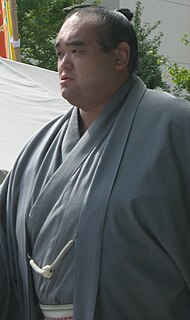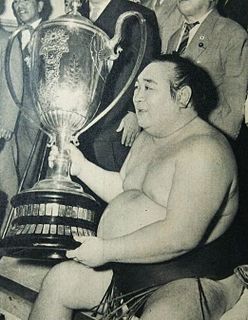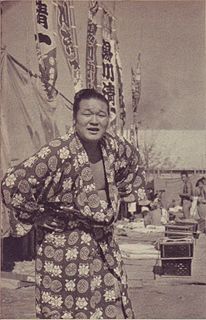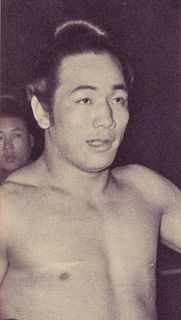 W
WAminishiki Ryūji is a retired Japanese sumo wrestler. He made his professional debut in 1997 and reached the top makuuchi division in 2000. He earned twelve special prizes and won eight kinboshi or gold stars for defeating yokozuna. He was twice runner-up in a tournament. The highest rank he reached was sekiwake. After more than 22 years as an active wrestler he retired in July 2019 at the age of 40. He is in the all-time top ten for a number of sumo records, including most career wins, most top division appearances and most tournaments ranked in the top division. He wrestled for Isegahama stable.
 W
WAsahifuji Seiya is a Japanese former professional sumo wrestler from Aomori. He joined professional sumo in 1981, reaching the top makuuchi division just two years later. He reached the second highest rank of ōzeki in 1987 and became the 63rd yokozuna in the history of the sport in 1990 at the age of 30. He won four tournaments and was a runner-up on nine other occasions. He retired in 1992 and is now the head coach of Isegahama stable. As a coach he has produced two yokozuna himself, Harumafuji and Terunofuji.
 W
WAsōfuji Seiya is a retired sumo wrestler from Fukaura, Nishitsugaru, Aomori, Japan. His highest rank was maegashira 13. He is the elder brother of Aminishiki.
 W
WBushūyama Takashi is a Japanese former sumo wrestler from Aomori, Aomori Prefecture. He made his professional debut in January 1999. At the age of 32, he was promoted to the top makuuchi division in the November 2008 tournament. His highest rank was maegashira 3. He is now a sumo coach.
 W
WHōchiyama Kōkan is a former sumo wrestler from Hirosaki, Aomori Prefecture, Japan. He joined professional sumo in 2000. His highest rank was maegashira 14, achieved in 2006. After illness saw him demoted to the third makushita division in 2008, he returned to the second highest jūryō division in 2010 and the top makuuchi division in September 2011. After winning the Sandanme division he had just been demoted to in November 2013, he chose to retire. He is now a coach at Sakaigawa stable.
 W
WHomarefuji Yoshiyuki is a retired professional sumo wrestler from the town of Ajigasawa in Aomori prefecture, Japan. A former amateur champion, he made his professional debut in January 2008 and wrestled for Isegahama stable, one of the more successful stables in sumo today. He reached the top makuuchi division for the first time in May 2013. His highest rank was maegashira 6. He retired in 2019 to become an elder of the Japan Sumo Association under the name Tateyama.
 W
WIwakiyama Ryūta, is a former sumo wrestler. A former amateur sumo champion, he turned professional in 2000 and reached the top division at the end of 2002. The highest rank he reached was komusubi. He was a runner-up in one tournament and earned two special prizes in his career. After his retirement in 2010 he became an elder of the Japan Sumo Association under the name Sekinoto.
 W
WJūmonji Tomokazu is a former sumo wrestler from Aomori, Japan. Joining the professional ranks in 1992, he reached the top division in 2000 and was ranked there for 34 tournaments until 2007. His highest rank was maegashira 6. He was forced to retire in April 2011 after an investigation by the Japan Sumo Association found him guilty of match-fixing.
 W
WKagamiiwa Zenshirō was a sumo wrestler from Aomori Prefecture, Japan. His highest rank was ōzeki.
 W
WKagamisato Kiyoji was a Japanese professional sumo wrestler from Aomori Prefecture. He was the sport's 42nd yokozuna.
 W
WKaihō Ryōji is a former sumo wrestler from Aomori, Japan. His highest rank was komusubi. An amateur champion at Nihon University, he entered professional sumo in 1996. He was one of the lightest sekitori wrestlers in recent years. He won two special prizes for Technique. He retired from active competition in 2010 and became a coach, but in April 2011 he was asked to resign from the Japan Sumo Association after being found guilty of match-fixing.
 W
WKashiwado Risuke was a sumo wrestler from Goshogawara, Aomori, Japan.
 W
WMainoumi Shūhei is a former sumo wrestler from Aomori, Japan. His highest rank was komusubi. During the 1990s he was one of the most popular wrestlers in sumo due to his wide variety of techniques and great fighting spirit in battling opponents nearly twice his size.
 W
WMasatsukasa Kōshin is a former sumo wrestler from Aomori Prefecture, Japan. His highest rank was maegashira 8. He was forced to retire in April 2011 after an investigation by the Japan Sumo Association found him guilty of match-fixing.
 W
WOiteyama Hirokuni, born Mitsugu Yamaguchi, was a sumo wrestler from Goshogawara, Aomori, Japan. He made his professional debut in May 1953 and reached the top division in May 1960. His highest rank was maegashira 6. Upon retirement from active competition he became an elder in the Japan Sumo Association. He reached the Sumo Association's mandatory retirement age of 65 in June 2003.
 W
WŌnoshō Fumiya is a Japanese professional sumo wrestler from Aomori Prefecture. He debuted in sumo wrestling in January 2013 and made his top makuuchi debut in May 2017. His highest rank has been komusubi, and he has won three special prizes for Fighting Spirit, one for Outstanding Performance and two kinboshi for defeating yokozuna. He wrestles for Ōnomatsu stable.
 W
WShimizugawa Motokichi was a Japanese sumo wrestler from Goshogawara, Aomori, Japan. His highest rank was ōzeki.
 W
WTakamisakari Seiken is a former sumo wrestler from Aomori Prefecture, Japan. A former amateur champion, he turned professional in 1999 and established himself in the top division in 2002 after a brief appearance in 2000. He received five special prizes for his achievements in tournaments and earned two gold stars for defeating yokozuna. The highest rank he reached was komusubi, which he held on two occasions. He was one of the most popular wrestlers in sumo in his time, largely due to his eccentric warm-ups before his matches. He retired in January 2013 to become a coach at Azumazeki stable, having taken the toshiyori-kabu Furiwake-oyakata. In January 2020 he became head coach of Azumazeki stable, following the death of the former Ushiomaru.
 W
WTakanonami Sadahiro was a Japanese sumo wrestler and coach from Aomori. He held sumo's second highest rank of ōzeki from 1994 until 2000. He won two tournament championships, and was a runner-up in eight others. He was a sumo coach from his retirement in 2004 until his death in 2015 at the age of 43.
 W
WTakanosato Toshihide , real name Toshihide Takaya , was a Japanese professional sumo wrestler from Namioka, Aomori. He was the sport's 59th yokozuna from 1983 to 1986 and won four top division tournament championships. After retirement he established Naruto stable which he ran from 1989 until his death.
 W
WTakarafuji Daisuke is a Japanese professional sumo wrestler from Nakadomari, Aomori. He is a sandanme division champion. The highest rank he has reached is sekiwake.
 W
WTochinoumi Teruyoshi was a Japanese professional sumo wrestler from Aomori. He was the sport's 49th yokozuna, earning promotion in 1964. He was somewhat overshadowed by his yokozuna contemporaries Taihō and Kashiwado, but he was a noted technician and earlier in his career won six special prizes for Technique. He was one of the lightest yokozuna ever at just 110 kg. After his retirement from active competition in 1966 he was a coach at Kasugano stable, and was head coach from 1990 until his retirement in 2003.
 W
WWakanohana Kanji I was a Japanese professional sumo wrestler. He was the sport's 45th yokozuna. He was a popular wrestler and was nicknamed the "Devil of the Dohyō" due to his great fighting spirit and endurance.
 W
WWakanohana Kanji II is a Japanese former professional sumo wrestler from Ōwani, Aomori. He was the sport's 56th yokozuna. After retirement he became head coach of Magaki stable. Due to poor health he left the Japan Sumo Association in December 2013.
 W
WWakanosato Shinobu is a retired sumo wrestler from Hirosaki, Aomori, Japan. He made his debut in the top division in 1998, and his highest rank was sekiwake. He holds the record for the most consecutive tournaments ranked in the junior san'yaku ranks of sekiwake and komusubi. He won ten special prizes and was twice runner-up in a tournament. He earned two gold stars for defeating yokozuna at a maegashira rank. He had 1691 career bouts, sixth on the all-time list. He retired in 2015 and was a coach at Tagonoura stable, until opening his own Nishiiwa stable in February 2018.